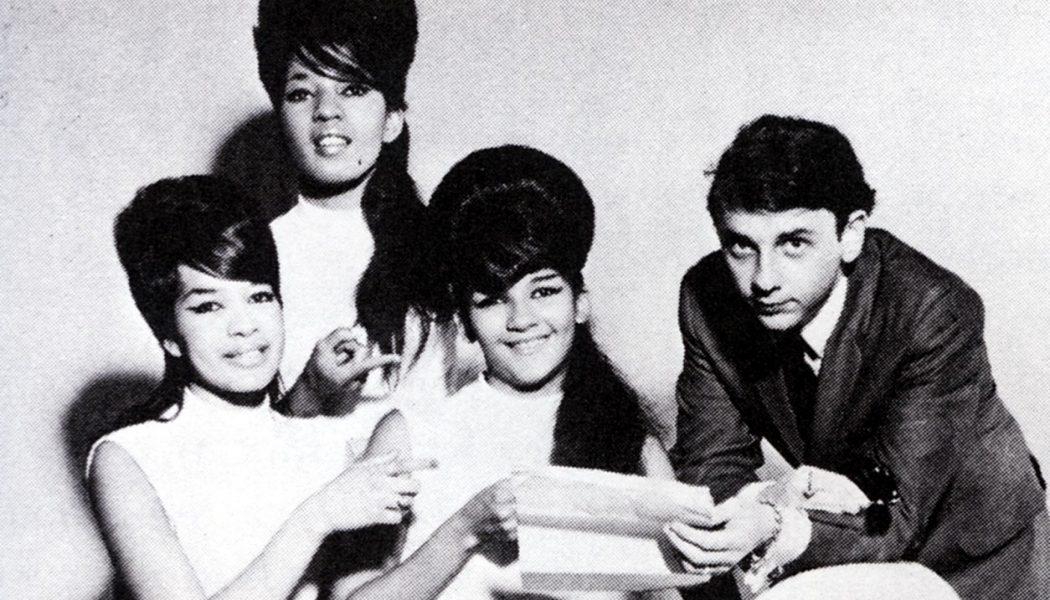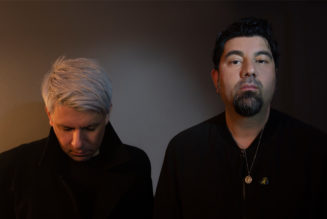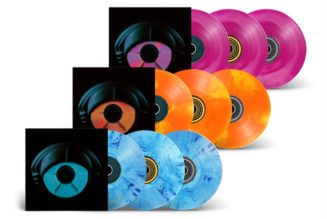
The Crystals, “Da Doo Ron Ron” (1963)
After many of the first-wave American rock ambassadors dropped off the scene temporarily (such as Little Richard and Elvis Presley) or permanently (such as Buddy Holly and Ritchie Valens), it seemed there wasn’t much innovation in rock until the Beatles arrived. Phil Spector was a major exception to that rule in the U.S., however, and the Crystals’ “Da Doo Ron Ron” is a perfection distillation of musical approach: A simple, lyrically uncomplicated song delivered with a youthful enthusiasm from a group of young African American females, augmented by an impenetrable wall of orchestral pop at a breakneck pace (courtesy his group of studio pros known as the Wrecking Crew). With Dolores “LaLa” Brooks on lead, the Crystals spat out admittedly silly adolescent declarations like this one as if nothing else in the world mattered except for the moment a cute boy or girl caught your eye; the snowballing energy of the recording rips you along for the ride whether you’re ready for romance or not.
The Ronettes, “Be My Baby” (1963)
Part of the appeal and brilliance of the Wall of Sound approach was that it worked not only for propulsive pop-rockers like the aforementioned Crystals tune, but it injected the simmering, irrepressible energy of teenage hormones into songs such as this game-changer. While a different producer might have approached this as an austere or saccharine ballad, Spector’s layered production – punctuated by that decisive, oft-imitated drum beat from Hal Blaine – makes “Be My Baby” feel like a dance song despite the easy-going pace. The essential ingredient is Ronnie Spector, whose deft negotiation between romantic infatuation and restraint ensured that “Be My Baby” would give birth to countless pop chart descendants. Heck, some might even say it’s the greatest girl group song of all time.
The Crystals, “Then He Kissed Me” (1963)
If there was ever a pop song that could make you believe in happily ever after for two teenage sweethearts, this is the one. LaLa Brooks’ vocal expertly builds from romantic indifference to head-over-heels devotion as that sweetly optimistic guitar tone rings out and a gentle, unshakable rhythm percolates beneath Spector’s mini orchestra. As always on Spector’s finest productions, the strings swoop in at just the right moment and make a quiet exit before overwhelming the honestly of the lead vocal with forced sentimentality. The result is one of the loveliest odes to the way a simple kiss can lead to a lifetime – and even if you don’t really believe in that, you will for the two minutes and forty seconds of this song.
Righteous Brothers, “You’ve Lost That Lovin’ Feelin'” (1964)
If Spector’s girl group hits demonstrated brevity and restraint, his work with the Righteous Brothers allowed him to indulge his more operatic compositional inclinations. A slow, somber number that delicately builds to a thunderous, widescreen chorus, “You’ve Lost That Lovin’ Feelin'” finds the blue-eyed soul duo drenched in soul-wrenching, Sirkian drama. A Billboard Hot 100 No. 1 and enduring karaoke favorite, “Feelin'” verges on histrionics but sticks the landing. Spector is also listed as producer on their equally iconic “Unchained Melody,” though the duo’s Bill Medley insists his involvement was minimal on that one.
Ike & Tina Turner, “River Deep – Mountain High”
A song that sounds exactly like its title, “River Deep – Mountain High” crests and dips like a majestic bird of prey swooping through the Great Smokies, with Tina Turner – perhaps the greatest vocalist of her era, period – alternately mining her rich lower range and flaunting her effortless vocal peaks on this strange melange of gospel, doo-wop and classical. The unconventional structure and pacing made this one a tough sell at radio, and after it stalled at No. 88 on the Hot 100, Spector retreated for a couple years. But its reputation has swelled like the chorus since then, becoming one of Tina’s most respected studio recordings in a career stuffed with classics. (Then-husband Ike doesn’t appear on the recording but was listed as an artist per an agreement with Spector, who was solely interested in working with Tina.)
Veronica, “So Young” (1964)
If “Lovin’ Feelin'” and “River Deep” found Spector exploring his penchant for blockbuster storytelling, “So Young” is the flip side of that: a narrow focus on a small drama that nevertheless means the world to those caught up in it. In this case, the issue is “how young is too young to get married?”, certainly a topic of some interest for the record-buying teenage public in 1964. Ronnie Spector (here billed solely by her birth name Veronica) imbues the song with a reflective melancholy, as if she knows society will ultimately best the wishes of her heart; the ethereal, restrained production gives her lamentation an almost religious quality.
Darlene Love, “Christmas (Baby Please Come Home)” (1963)
Even back in the ’60s, writing an original Christmas classic was a tall order: Most successful holiday singles were mere novelties, fun for sing-alongs but not terribly meaningful. Working with frequent collaborators Ellie Greenwich and Jeff Barry, Spector co-wrote and produced an emotionally devastating vignette about a broken romance during the so-called Most Wonderful Time of the Year. Darlene Love belts “Christmas (Baby Please Come Home)” with a beautiful desperation, painting a Rockwellian portrait of a perfect Dec. 25 while simultaneously tearing your heart out. The secular glory of Mariah Carey’s “All I Want for Christmas Is You” is almost unthinkable without this one shoveling a path through the snowbank first.
The Beatles, “Let It Be” (1970)
Paul McCartney might have been right to retch at what Phil Spector did to “The Long and Winding Road,” but it’s hard to argue with the girl group auteur’s treatment of Macca’s most emotionally resonant composition. While George Martin produced the single version, Spector made subtle but impactful changes to the album version, pushing up the horns in the mix, emphasizing Ringo Starr’s soft teasing of the hi-hats and giving the crackling guitar solo from George Harrison (a different take from the single version) a bit more room to breathe.
John Lennon, “Imagine” (1971)
Every celebrity’s favorite ‘music with a message’ song, “Imagine” has elicited tears and sneers over the past half century, but there’s no denying it’s one of the most internationally popular social change anthems. John Lennon tapped Spector as co-producer for the Imagine title track, and Spector turned to composer Torrie Zito for the accompanying string arrangement; unlike his sonically stuffed ’60s productions, Spector let the orchestral bits waft in and out of “Imagine,” making it one of his airiest, least invasive productions.
George Harrison, “What Is Life” (1970)
The most exuberant track on George Harrison’s solo debut All Things Must Pass, “What Is Life” opens with a reverb-soaking guitar riff that sounds like a valiant attempt to mimic Spector’s Wall of Sound using just one instrument. If less is more on “Imagine,” second and third helpings of the sanguine sonics in this dense production remind us that excess can occasionally be best when it comes to the feast of “Life.” A veritable horn of plenty (with horns a’plenty) from the studio maestro, “What Is Life” is a booming celebration of life from the supposedly quiet Beatle.










